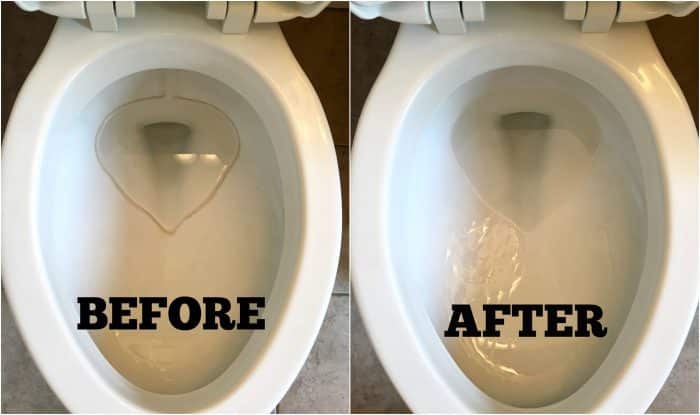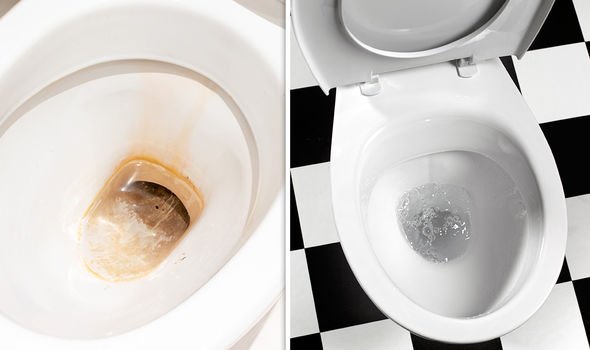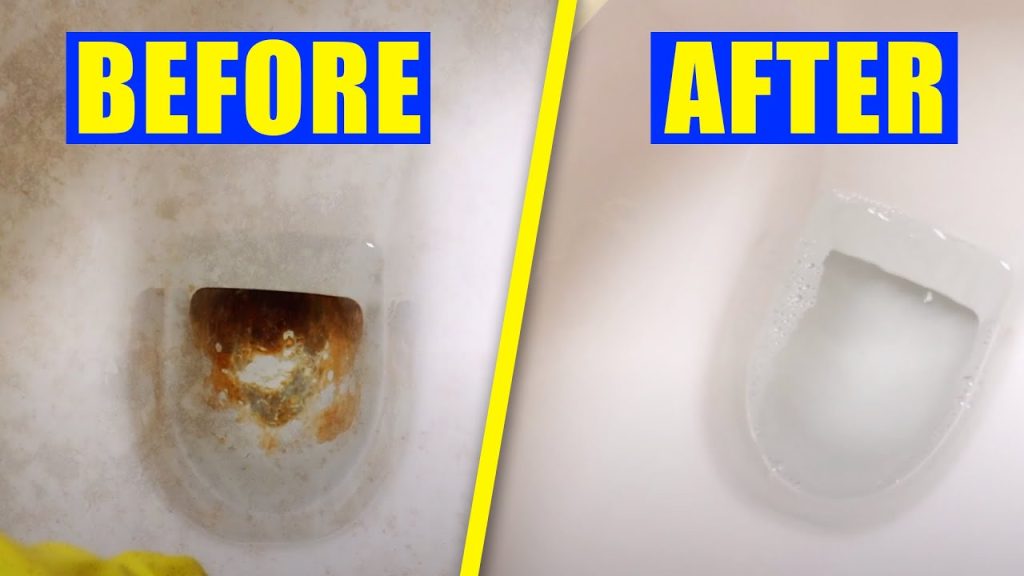To remove scale from a toilet bowl, use a combination of vinegar and baking soda. Apply the mixture, let it sit, then scrub with a toilet brush.
Battling with scale buildup in toilet bowls is a common household chore that can detract from bathroom cleanliness and aesthetics. Limescale, a hard chalk-like substance caused by minerals in hard water, often clings to the porcelain, making toilets look unsightly.
Tackling this issue does not necessarily require harsh chemicals. Many homeowners now opt for environmentally safer and readily available items like vinegar and baking soda, which are effective at dissolving scale. Engaging in a regular cleaning routine not only maintains a pristine toilet but also extends its lifespan and operational efficiency. By following simple yet effective home remedies, you can keep your toilet free from the unappealing sight of limescale and ensure a hygienic bathroom environment.

Credit: theforkedspoon.com
Introduction To Toilet Scale Accumulation
A sparkling clean toilet is a pride of any bathroom. Yet, over time, a stubborn problem arises: scale accumulation. This unsightly build-up can tarnish the appearance of your toilet and affect its performance. In this section, we delve into what causes this bothersome issue and how it impacts your toilet’s cleanliness.
Understanding The Causes Of Scale Buildup
The main villain in the story of toilet scale is hard water, which is high in minerals. These minerals, chiefly calcium and magnesium, stick to surfaces and form a hard, crusty layer. Factors contributing to scale include:
- Evaporated water leaving behind minerals
- Frequent use without regular cleaning
- Water standing still for long periods
The Impact Of Hard Water On Your Toilet’s Cleanliness
When hard water flows through your toilet, it leaves a trail of minerals. These contribute to the dingy appearance of your bowl and potentially hinder the efficiency of your flush. Hard water can cause:
| Impact | Consequence |
|---|---|
| Stains | Unsightly brown or white marks |
| Build-up | Lowered flushing power and potential blockages |
| Bad odors | Persistent unpleasant smells |
This section will guide you through the necessary steps to return your toilet to its original glimmer and ensure it runs smoothly.
Preventive Measures To Avoid Scale
With regular use, toilets can develop unsightly scale buildup. Preventing scale proactively is less work than removing it. Adopt these strategies to keep your toilet sparkling and scale-free.
Regular Cleaning Habits
Consistent cleaning goes a long way in preventing scale. Create a cleaning routine to tackle dirt before it hardens.
- Weekly scrubbing with a toilet brush prevents scale buildup.
- Use vinegar for its natural acidic properties. It dissolves minerals.
- Drop a borax solution into the bowl overnight once a month.
Water Softening Solutions And Their Role
Hard water contributes to scale. A water softener minimizes mineral deposits.
| Type of Water Softener | Role in Scale Prevention |
|---|---|
| Salt-Based Softener | Exchanges minerals with salt to soften water |
| Salt-Free Conditioner | Crystallizes minerals to prevent sticking |
| Magnetic Softener | Uses magnets to change mineral properties |
Select the right softener to keep minerals from forming hard, crusty deposits.
Essential Supplies For Scale Removal
Facing tough scale in your toilet bowl requires the right approach and supplies. Before diving into the cleaning process, equip yourself with the essentials. Choosing between natural and chemical cleaning agents is a big decision, as is selecting the proper physical tools for the job. Here, we’ll explore both options.
Natural Vs. Chemical Cleaning Agents
Natural agents are safe for most households and environments.
- Vinegar: An acid that dissolves minerals.
- Baking soda: For an abrasive, scrubbing effect.
- Lemon juice: Another acidic option for scale breakdown.
Chemical agents pack a stronger punch.
- Commercial cleaners: Formulated specifically for limescale.
- Hydrochloric acid: Use with caution; it’s potent.
- Muriatic acid: Similar to hydrochloric, for severe cases.
Tools For Physical Scale Removal
Physical removal complements chemical treatment.
| Tool | Use Case |
|---|---|
| Pumice stone | Gentle abrasive for surfaces. |
| Scrub brush | For loosening and removing scale. |
| Toilet brush | Daily maintenance to prevent buildup. |
Diy Methods For Scale Removal
Dealing with scale in your toilet bowl can be a nuisance. Fortunately, there are effective DIY methods for scale removal that can restore the sparkle without the need for harsh chemicals. These methods are safe, inexpensive, and easy to find in your household.
Household Items You Can Use
Several everyday items are surprisingly effective at tackling toilet bowl scale. White vinegar, baking soda, and borax all have properties that can break down the minerals causing the scale. Here’s a list of items you can use:
- White Vinegar: Natural acid removes build-up.
- Baking Soda: Abrasive action scrubs away stains.
- Borax: A stronger mineral for stubborn stains.
Step-by-step Guide For Vinegar And Baking Soda Method
This combo works wonders on bathroom scales. Follow these simple steps:
- Pour: Empty one cup of white vinegar into the toilet bowl.
- Wait: Let it sit for 1-2 hours for the acid to work on the scale.
- Add Baking Soda: Sprinkle one cup of baking soda into the bowl.
- Add More Vinegar: Pour another two cups of vinegar in.
- Fizz Action: Watch as it fizzes, wait for half an hour.
- Scrub: Scrub the bowl with a toilet brush focusing on scaled areas.
- Flush: Flush the toilet to rinse away the scale and solution.
Commercial Cleaners For Tough Scale
The battle against tough toilet bowl scale often requires more than elbow grease. Commercial cleaners pack a punch with specially formulated chemicals. They effortlessly dissolve even the hardest of buildups. The right product turns a taxing chore into a swift victory.
Choosing The Right Commercial Cleaner
Choosing an effective cleaner involves a few important considerations:
- Scale Type: Identify whether it’s lime, calcium or rust buildup.
- Ingredients: Look for hydrochloric acid or sulfamic acid in the list. These are known scale busters.
- Eco-Friendliness: Seek out products with biodegradable materials. They protect the environment.
- User Reviews: Verify performance through user ratings and testimonials.
Picking the right cleaner ensures effectiveness. It saves both time and effort.
Safety Precautions When Using Chemical Cleaners
Chemical cleaners come with safety risks. Follow these precautions to use them safely:
- Read Labels: Follow manufacturer instructions precisely.
- Protective Gear: Always wear gloves and eye protection.
- Ventilation: Ensure the bathroom is well-ventilated during use.
- No Mixing: Never mix cleaners. Combining chemicals can release harmful gases.
Adhering to safety recommendations prevents harm to you and your household.

Credit: www.youtube.com
Mechanical Methods To Get Rid Of Scale
Removing scale from your toilet bowl can be straightforward. Mechanical methods scrub away the hard mineral deposits effectively. They ensure a sparkling clean bowl minus harsh chemicals.
How To Use A Pumice Stone Effectively
Using a pumice stone is safe and efficient for removing toilet scale. Follow these easy steps:
- Wet both the pumice stone and the toilet surface.
- Gently rub the stone on the scale areas in a circular motion.
- Frequently rinse the stone to wash away debris.
- Flush the toilet to clear any remaining residue.
Note: Always keep the stone and toilet wet to prevent scratches.
When To Consider Using A Toilet Brush Or Scraper
To maintain your toilet and quickly address light scale, a toilet brush or scraper is useful. Use these tools:
- For regular maintenance: A brush works after each flush to stop scale from forming.
- For tougher scale: A scraper can break up deposits before a deep clean.
Using a toilet brush or scraper routinely keeps the bowl scale-free and hygienic.
Protective Care Post-scale Removal
After ridding your toilet bowl of limescale, ongoing care is key. This section guides you through maintaining a pristine toilet post-scale removal. Implement these simple yet effective strategies to keep scale at bay.
Maintenance Cleaning Schedule
Consistency prevents scale buildup. Stick to a routine to avoid future hassles. Here’s a simple schedule:
- Weekly: Clean your toilet with a mild cleaner. Scrub gently.
- Bi-Weekly: Use a specialized toilet cleaner to break down any starting buildup.
- Monthly: Deep-clean the bowl. Use a toilet pumice stone on any stubborn spots.
Products To Prevent Future Scale
Choose products wisely to maintain a scale-free toilet bowl. Consider these:
| Type | Product | Usage |
|---|---|---|
| Cleaners | Phosphoric acid-based | Bi-weekly |
| Rinse Aids | Water softening | In each flush |
| DIY Solutions | Vinegar and Baking Soda | Monthly |
Pro tip: Read labels for eco-friendly options that are safe for septic systems.
Professional Cleaning Services
Even with regular cleaning, toilets can develop stubborn scale. This hard, crusty deposit comes from minerals in the water. Over time, it can cause unsightly stains and odors. That’s when professional cleaning services step in. They use powerful products and methods to tackle the toughest toilet bowl scale.
When To Call The Experts
Spotting the early signs of scale buildup will save you time and money. Call expert cleaners if you notice:
- Persistent stains after regular cleaning.
- Strong odors that don’t fade with general use.
- A buildup of rough texture in the toilet bowl.
What To Expect From A Professional Cleaning Service
A professional service does more than just scrub your toilet. They provide a deep, lasting clean. Expect the following:
- An initial assessment of the scale severity.
- Use of specialized cleaning agents that are tough on scale but gentle on surfaces.
- Complete removal of scale, leaving your toilet looking new.
- Maintenance tips to prevent future buildup.
Troubleshooting Common Scale Removal Issues
Troubleshooting common issues with scale removal from toilet bowls can be tricky. Removing scale is not just about pouring chemicals and scrubbing. The type of scale, water hardness, and previous cleaning methods affect how easily scale comes off. In this section, let’s tackle common problems you might face and offer practical solutions for them.
Dealing With Stubborn Scale Deposits
Hard water can leave behind tough scale deposits that regular cleaning won’t remove. These deposits can be chalky or hard, often appearing under the rim or at the water line.
- Start with vinegar – let it sit overnight to break down the scale.
- Use a pumice stone for scrubbing but wet it first to prevent scratches.
- For very tough deposits, muriatic acid can be an option, but it must be used with extreme caution.
Persistence and the right approach can get even the most persistent deposits out. Repeat the vinegar treatment if necessary, and always wear gloves to protect your hands.
Avoiding Damage To Toilet Bowl Surfaces
While removing scale, it’s important to avoid damaging the toilet bowl. The wrong method can leave permanent scratches or damage the glaze.
- Never use metal scrapers or steel wool on the porcelain.
- Choose mild, non-abrasive cleaners and use soft brushes or sponges.
- Read labels on cleaning products to make sure they are safe for toilet surfaces.
Remember: keeping your toilet clean from the start is easier than tackling scale later. Regular cleaning can prevent scale build-up, extending the life and shine of your toilet bowl.
Eco-friendly Alternatives For Scale Management
Limescale in toilet bowls is stubborn. Yet, eco-friendly solutions work wonders. No need for harsh chemicals. Instead, these natural approach offers a safer, greener clean.
Biodegradable Cleaners
Plant-based biodegradable cleaners are tough on scale. They protect aquatic life and break down easily. Look for the following attributes:
- Non-toxic
- Phosphate-free
- Biodegradable ingredients
Brands may vary. Check for eco-certifications. These are indicators of a true eco-friendly product.
Using Citric Acid And Other Natural Substances
Citric acid is an effective limescale remover. It’s found naturally in fruits like lemons and limes. To use:
- Combine 1/2 cup of citric acid powder with 1/2 gallon of water.
- Pour the solution into the toilet bowl.
- Let it sit overnight.
- Scrub with a toilet brush and flush in the morning.
Other natural substances include:
| Substance | Application |
|---|---|
| Baking Soda | Sprinkle in bowl, add vinegar, scrub after fizz. |
| Vinegar | Full-strength, soak, then scrub, for serious scale. |
| Borax | Mix with water, apply, scrub for a sparkling bowl. |
Conclusion & Best Practices
Successfully removing scale from toilet bowls maintains cleanliness and prolongs the fixture’s life. Adopting proper techniques ensures a sparkling, scale-free toilet, contributing to an overall hygienic bathroom environment.
Summarizing Key Takeaways
Removing scale from a toilet bowl requires regular cleaning and proper technique. Using household items like vinegar and baking soda can effectively break down and remove scale buildup. Commercial cleaners offer a stronger solution but always follow manufacturer instructions for safety.
Final Tips For Keeping Your Toilet Scale-free
- Maintain a regular cleaning schedule.
- Consider weekly vinegar soaks for prevention.
- Use a pumice stone for stubborn scale.
- Flush regularly and keep water circulating.
- Invest in a water softening system if hard water is an issue.

Credit: poppies.co.uk
Frequently Asked Questions On How To Remove Scale From Toilet Bowl
How Do You Remove Hard Scale From Toilet?
Pour vinegar into the toilet bowl and let it sit for several hours. Scrub with a toilet brush, focusing on affected areas. Flush to rinse away the scale. Repeat if necessary.
How Do I Get Rid Of Brown Limescale In My Toilet?
Pour white vinegar into the toilet and let it sit for an hour. Scrub with a toilet brush, targeting brown limescale deposits, and flush. Repeat if necessary for stubborn stains.
How Do You Get Rid Of Calcium Deposits In Toilet Bowl?
To remove calcium deposits from a toilet bowl, pour vinegar into the bowl and let it sit overnight. Scrub the bowl with a toilet brush the next morning to eliminate the buildup. Rinse by flushing the toilet.
Does Wd 40 Remove Limescale From Toilets?
Yes, WD-40 can remove limescale from toilets. Apply WD-40, let it sit for a few minutes, then scrub with a toilet brush and flush.
Conclusion
Banishing scale from your toilet bowl need not be a daunting task. Armed with the right techniques and household products, you can restore your toilet’s sparkle. Regular maintenance prevents buildup and keeps cleaning efforts minimal. Remember, a clean toilet contributes to a healthy, hygienic home.
Start your battle against scale today and enjoy the gleaming results!

